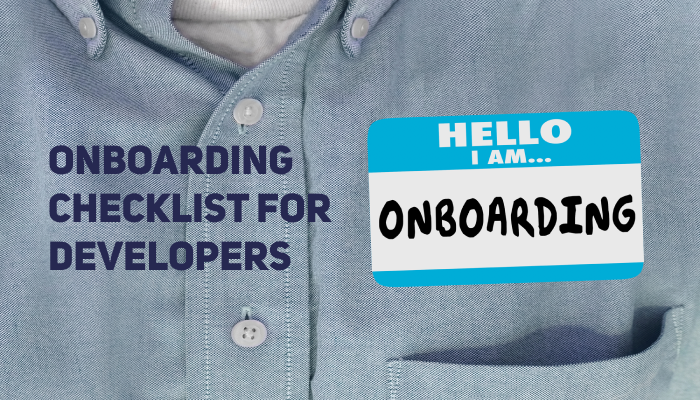Ultimate Onboarding Checklist for Web Developers (Bonus: Onboarding Checklist for Freelancers)

Ultimate Onboarding Checklist for Web Developers (Bonus: Onboarding Checklist for Freelancers)
Let’s be honest, onboarding is the most undervalued and least developed hiring procedure so often overlooked by the senior managers and, as a result, HR departments. Although quite recently onboarding has received attention in recruitment circles, procedures still remain erratic, casual, undocumented, limited in scope, and sometimes non-existent at all.
Notwithstanding, onboarding is an extremely important process that can significantly increase performance, dramatically improve cultural fitness, and prepare new hires for the actual jobs.
If you’re a team leader, a recruiter, or anyone holding a managerial position, then consider onboarding as a culture-shaping competitive advantage.
In this piece, we’ll define the term, describe the process of onboarding for developers, and share a sample onboarding checklist for developers and remote employees or those both if you happen to hire remote developers.
What is onboarding?

Onboarding?
Onboarding is the process of not only acquiring, accommodating, and assimilating new employees, but also accelerating their learning and amplifying their voices. In order to prepare your company for successful onboarding, you’ll need to make sure your team agrees on the need of having a new member; your company has crystal clear procedures on identifying, selecting, interviewing, and recruiting new employees; you have all the tools for new team members to do their job; you, as a leader, understand the necessity to help people join the team smoothly so they can work with others and deliver their best results together.
Idiosyncrasies of technical onboarding

What if … well, nevermind
Before we move on to the process of onboarding per se, let’s outline some of the key features pertaining to the technical onboarding that might make the whole process easier or more complicated.
First of all, onboarding is about people. And developers, just so it happens, are a peculiar bunch: while some might be more extroverted than others, usually they are more or less reserved and self-reliant. Without getting too much into stereotypical thinking or writing a psychology book instead of a practical manual for recruiters and leaders, let’s briefly point out the main characteristics associated with a developer persona:
Developers might seem apprehensive about participating in an extensive onboarding process;
Developers are frequently self-learners, thus it’s important to find out ways they prefer to learn new things or familiarise themselves with an unfamiliar environment;
Onboarding for freelance developers is just as important as for office workers;
A few developers might not be familiar with an agile method of working or come from a different corporate cultural background with little or no desire to collaborate. If that’s the case, ensure you teach them agile development during onboarding.
What’s onboarding for developers?

Onboarding: expectations
Now, let’s look at the onboarding process closely. Usually, onboarding comprises three main sub-processes: pre-onboarding, onboarding, and post-onboarding.
Pre-onboarding happens before your new hire appears for the first time on the job. During this time, it’s best to prepare all the hardware and software available and working, make sure the new employee has access to the building, and prepare all the financial and legal documents for signature.
During pre-onboarding, it’s important to ensure the new hire won’t spend their time on unnecessary paperwork or wait downstairs for access, and all those other trivial things that might spoil the first day or become timewasters.
Pre-onboarding also means sending them access (login/pass) to all-important software tools before they open up their laptops on the job. Developers want to start coding asap, so getting minuscule unimportant staff out of the way as quickly as possible will result in happier developers.
Onboarding happens as soon as the new hire enters the door to your office. This time is critical and there’s nothing you can shorten or disregard about it. Greet the person and become a welcoming session by showing a person around and introducing them with the fellow developers on the person’s team, allow the new hire to introduce themselves without getting them embarrassed or barraged by unnecessary questions. After the short introductory lecture and turnaround, get them acquainted with the code of conduct and other company policies, including those that cover the mission, the vision of the company and everything else in-between. Then, talk them through coding standards, expectations, various tools of the trade, and software. By the end of the onboarding session make sure you pair the new hire with someone else on the team so they can walk the person through the learning curve.
If we’re not talking startups, but large companies, then it’s a nice idea to ask them to contribute to the onboarding process with their own subject matter. For example, HR can provide a workshop on Harassment-Free Workplace, Security Department can make a presentation on various security and data bridge issues, IT — on Information Systems, Physical Training — on safe work practices, etc.
And finally, post-boarding includes watching over the new employee closely for the next few months ensuring they are satisfied with the working conditions, do not have questions, progress smoothly and effectively in their knowledge, etc. Meanwhile, it’s important to get feedback about the onboarding process from new employees and from those surrounding the new hire, that is — team members.
I found a few additional resources that will take you from here, in case you might need to do more reading on the subject:
A curated list of awesome onboarding resources on GitHub
A curated list of awesome resources on remote work on GitHub
Ultimate onboarding checklist

Ultimate onboarding checklist
Below, please find a general list of suggested onboarding procedures:
Pre-onboarding:
- Send a welcoming email
- Prepare and send a contract
- Review the contract if need be
- Send NDA
- Ask for and collect personal information (ID, SS, phone, emergency phone, etc.)
- Give building access
- Add to communication systems
- Add to project management systems
- Set up knowledge sharing
- Send a list of login details over email
- Add to payroll
- Arrange benefit packages
- Prepare any work-related documentation (tech docs on software, business processes, etc)
Onboarding:
- Introduce to the team
- Company overview: mission, vision, goals
- Tour the office
- Let them learn the software
- Familiarize with the workflow
- Assign a mentor
- Set goals and expectations
Post-onboarding:
- Assign a test project
- Arrange one-on-one meetings with team members
- Arrange end-of-day meetings with a mentor
- Schedule training
- Review performance on a weekly/monthly basis
- Evaluate the onboarding process and ask for feedback
- Develop a solid learning & meeting plan
Bonus: Onboarding checklist for remote employees

Onboarding checklist for remote employees
First of all, let’s settle with a few recommendations for virtual teams’ onboarding:
- Use recruitment software to guide people through the paperwork of hiring remotely
- Use the online tracking system (like Hubstaff) to track developer hours, including those spent on onboarding
- Use online videos and tutorials to help new hires learn about the company
- Develop an effective new employee website, online learning center, or e-learning modules, where they’ll take tests, check completed assignments, learn company news, see current updates, etc.
- Use video conferencing, messaging, chatting software
- Assign onboarding facilitators (people responsible for the onboarding process)
- Create guidebooks, flipbooks, checklists, references, video tutorials, etc.
Here’s a basic checklist:
- Send a welcoming email
- Prepare and send a contract (use an e-signature tool, like HelloSign or DocuSign)
- Review the contract if need be
- Send NDA
- Ask for and collect personal information (ID, SS, phone, emergency phone, etc.)
- Add to communication systems (group messaging tool, video conferencing software, etc)
- Add to project management systems
- Set up knowledge sharing
- Send a list of login details over email
- Add to payroll
- Arrange benefit packages
- Prepare any work-related documentation (tech docs on software, business processes, etc)
- Send employee handbooks and other work-related documentation in digital format
- Assign an onboarding facilitator
- Introduce to the team
- Arrange training on computer security, password management, and data encryption
- Let them learn the software
- Use interactive training courses
- Send product demos or video tutorials
- Follow up after each training session
- Assign a mentor
- Set goals and expectations
- Assign a test project
- Arrange one-on-one video calls with team members
- Arrange end-of-day video calls with a mentor
- Schedule other online trainings
- Review performance on a weekly/monthly basis
- Evaluate the onboarding process and ask for feedback
- Develop a solid learning & meeting plan
In conclusion, it’s worth saying that onboarding should never be disregarded: even the simplest procedure can increase employee performance by as much as 10 % and retention – up to 60%. Moreover, onboarding improves and strengthens employees’ morale, reduce time to productivity, and boost overall commitment and engagement. Try and see for yourself.
And by the way, if you have any horrible onboarding stories, feel free to shoot them in comments 😉











No comments yet